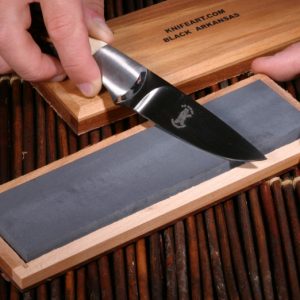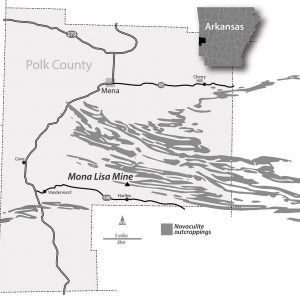calsfoundation@cals.org
Novaculite
Novaculite is a hard, dense, white-to-grayish-black sedimentary rock, composed of microcrystalline quartz. It is translucent on its thin, sharp edges and usually breaks with a smooth conchoidal (shell-like) fracture. The word “novaculite” is derived from a Latin word meaning “razor stone.” Novaculite is found in the Ouachita Mountains in formations that are highly resistant to erosion. These formations range from about 250 to 900 feet in thickness.
There are two categories of Arkansas novaculite classified by the abrasives industry. The “Washita” stone has the dull luster of unglazed porcelain. It is more porous and less dense than the “Arkansas” stone, which is extremely fine-grained with a waxy luster. There has been recent interest in the fine-grained novaculite as a lapidary (jewelry-making) material. Any impurities add beautiful colors to specimens used for jewelry.
The mining of novaculite has been referred to as Arkansas’s oldest industry and remains economically important today. Prehistoric Native Americans fashioned weapons and tools from an abundant source of these silica-rich rocks. Tribes such as the Quapaw, Osage, Caddo, Tunica, Chickasaw, and Natchez mined novaculite. It was used for trade over much of North America. Little evidence remains of these digs today, but an Arkansas history textbook written in 1905, The History of Arkansas: A Text-book for Public Schools, High Schools, and Academies by Josiah H. Shinn, describes the many “ancient” quarries, some extending over a distance of four miles. The text states that these quarries were from fifteen to forty feet deep, ten to thirty feet wide, and 100 to 300 feet long. They were located in Hot Spring and Garland counties, but hundreds of square miles were strewn with the flakes, fragments of rejected novaculite pieces.
The first European inhabitants in Arkansas, French trappers, used novaculite for a whetstone to sharpen knives needed for preparing animal hides for trading.
Early settlers relied on novaculite to sharpen their woodcutting tools. These axes and saws were used to clear land for the introduction of agriculture. Carefully honed tools were needed for the logging industry in early Arkansas, as well as in modern times. As the Native Americans before them, settlers traded the very valuable novaculite for frontier essentials.
Because of the excellent quality of novaculite as an industrial abrasive, the market is expected to increase. Fire bricks, plastic additives, and ferro-silicon are other uses of Arkansas novaculite. At one time, the Butterfield Quarry produced novaculite used for the pure-fused glass known as Pyrex.
German and Japanese scientists have reported that novaculite from the Magnet Cove Stone Quarry in Hot Spring County is pure to 99.9 percent silica, the only known location of novaculite of this quality. It is used for testing gold and in the space and aircraft industries as a grit and polish material.
The lesser-quality grade of novaculite is quarried for use as concrete aggregate. Uses for these aggregates include road construction material and railroad ballast. This grade of novaculite comes from quarries extending from Little Rock (Pulaski County) westward into Polk County. However, top-quality whetstone-grade material is mined almost exclusively in Garland and Hot Spring counties. Arkansas is ranked first in the nation in silica stone (abrasives) production.
For additional information:
Baker, Charles M. “A Study of Aboriginal Novaculite Exploration in the Ouachita Mountains of South-Central Arkansas.” MA thesis, University of Arkansas, 1974.
Etchieson, Meeks and Mary Beth Trubitt. “Taking It to the River: Arkansas Novaculite Quarrying and Archaic Period Tool Production.” North American Archaeologist 34 (no. 4, 2013): 387–407.
Philbrick, John Byron Scott. “A Geochemical Analysis of the Arkansas Novaculite and Comparison to the Siliceous Deposits of the Boone Formation.” MS thesis, University of Arkansas, 2016. Online at https://scholarworks.uark.edu/etd/1520/ (accessed July 6, 2022).
Whittington, David B. “Arkansas’ Oldest Industry.” Arkansas Historical Quarterly 28 (Autumn 1969): 223–230.
Will, Madeline. “Novaculite Runs in Hot Springs’ Veins.” Arkansas Democrat-Gazette, July 1, 2012, pp. 1G, 8G.
Helen Pennington
Pine Bluff, Arkansas
 Novaculite Nail Files
Novaculite Nail Files  Novaculite Bench Stone
Novaculite Bench Stone  Novaculite Outcroppings
Novaculite Outcroppings 



Comments
No comments on this entry yet.